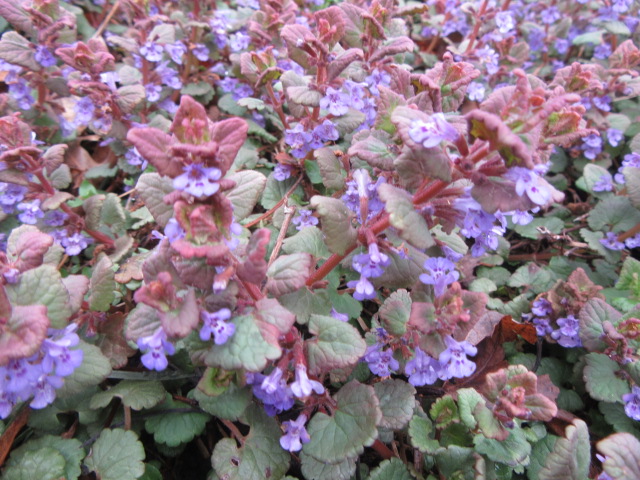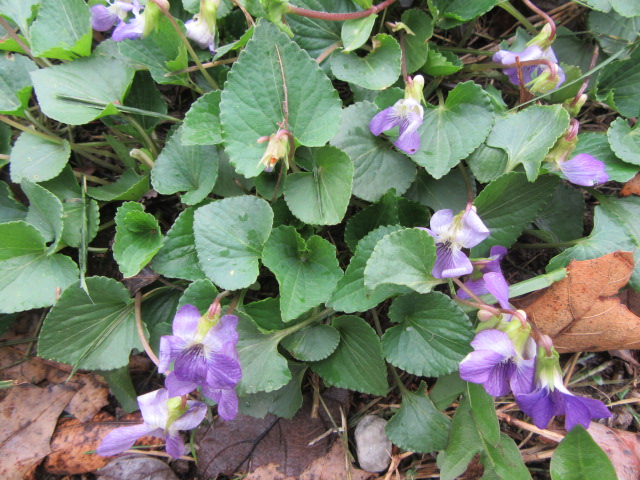
Hello AGAIN… While I was mowing Friday I noticed a patch of Henbit that didn’t look like the others. These were not as tall and at the time the flowers seemed a little bluer. So, today, I decided to go investigate further.
Upon further research, I found I had been mistaken before. I thought Henbit and Dead Nettle were the same and my photos were all labeled Lamium amplexicaule… As it turns out, Dead Nettle and Henbit are two different species…

As you can tell, the leaves of Lamium amplexicaule, commonly known as Henbit, are small and round.

The plants I had been calling Henbit are actually Dead Nettle, Lamium purpureum. The plants are taller, up to 10″, and the longer heart-shaped leaves are arranged in groups of four with a pagoda or pyramidal-type growth habit.

Other common names for the Lamium purpureum include Red Dead Nettle, Purple Dead Nettle, Red Henbit, and Purple Archangel.
The entire Lamium genus is known as the dead-nettles. They are native to parts of Africa, Europe, and Asia but somehow made their way to North America. Currently, Plants of the World Online by Kew lists 29 accepted species in the Lamium genus.
Both species are edible (stems, leaves, and flowers) and have a sweet peppery flavor and reminiscent of Celery.
Both species are very important to the ecosystem as they are one of the first wildflowers to bloom. They are very important to bees when they first come out of hibernation when food is scarce. I am not sure about the Henbit, but Dead Nettle has red pollen, so if you see bees with red on their hair you know they have been feeding on Dead Nettle.
The leaves are also eaten by deer and rabbits and their seed is eaten by birds. So, both these plants are very beneficial…

The Common Violet, or Common Blue Violet, is now flowering here. Originally, I had their folder and photos labeled Viola papilionaceae but today I noticed that name is now a synonym of Viola sororia. There are A LOT of these in the yard behind the old foundation and in the ditch by the street. There were also MANY in the backyard of the mansion in Mississippi.

Last spring I noticed a HUGE patch of these “oniony” looking plants growing by the lagoon. I didn’t mow them off at first, but after a while I did. It was strange I hadn’t noticed them until last spring. Where did they come from and how did the colony get so large without being noticed? I mentioned them to dad last spring and he didn’t have any comment. Sometimes I think he probably wonders about me… Well, anyway, they returned again.

They are fairly tall and the leaves don’t seem as thick as they were last spring. The weather has had a big impact on many species growth this spring. Although these definitely do look like some kind of an onion, their leaves don’t have much of an “oniony” odor when I squeezed them. Well, you never know… There are Grape Hyacinths and chives growing in the yard and they all look the same. I can only tell the difference when I mow over them or smell their leaves… Normally, the Hyacinths are all flowering this time of the year while the chives are not. This year, no. Most of the Hyacinths are not flowering (at least not yet).
While, no doubt, they are some kind of an Allium species like onions, shallots, garlic, etc., who knows which species. There are 960 Allum species… I would definitely like to know more about this colony so I will have to either mow around them or relocate them.
That’s it for this post. Now, I will work on the yard and bed tour… Until then, stay well, be safe, count your blessings and be thankful. Don’t forget to hug your loved ones and tell them they are AWESOME! They may even tell you that you are AWESOME, too! GEEZ! I feel a much-needed post coming on… Well, I have a problem I need to talk about but it will have to wait…
They DO look like onions don’t they. What a great time you must have in your garden. Enjoy!!
LikeLike
Miriam, I think they are onions but just don’t have much of an oniony odor yet. Time will tell. I really do enjoy gardening because I get close to nature and into the soul of the soil. Thanks for the comment!
LikeLike
Interesting post. We have lots of Violets. I encourage them in certain areas – in others, I dig them out. They can make a nice groundcover.
LikeLike
For the most part, I rarely remove them wherever they are. I think this is one plant that really thrives if they know you like them. They have really multiplied since I have been back, especially this spring. GEEZ! I let them grow in the garden in Mississippi and there was a lot by the time I left. In some areas they are so thick this spring I have just mowed around them. They are looking really good! Thanks for the comment, Jason!
LikeLiked by 1 person
This is very educational!
LikeLiked by 1 person
Thanks, Eflida! It was educational for me, too. Always like writing posts and pages I learn from myself. Life is very educational for sure. Thanks for the comment! Where are you off to next?
LikeLiked by 1 person
Gila Cliffs!
LikeLiked by 1 person
Ahhh… In New Mexico?
LikeLike
Yes!
LikeLiked by 1 person